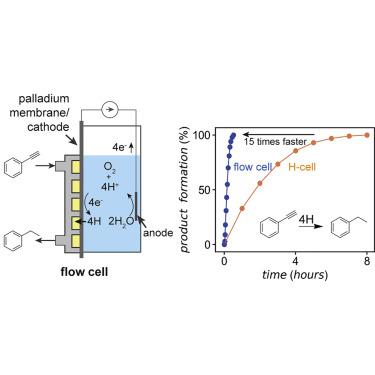Cell Reports Physical Science ( IF 8.9 ) Pub Date : 2020-07-08 , DOI: 10.1016/j.xcrp.2020.100105 Ryan P. Jansonius , Aiko Kurimoto , Antonio M. Marelli , Aoxue Huang , Rebecca S. Sherbo , Curtis P. Berlinguette

|
Electrocatalytic palladium membrane reactors (ePMRs) use electricity to hydrogenate organic molecules at ambient temperature and pressure. These benign reaction conditions position ePMRs as a sustainable alternative to thermochemical hydrogenation, which requires high-temperature and high-pressure reaction conditions. However, ePMRs suffer from slow reaction rates and a limited understanding of the factors that govern reaction performance in these devices. In this work, we report the design and validation of an ePMR flow cell. This flow cell increases reaction rates 15-fold and current efficiencies by 30% relative to H-cell reactors. We use this device to reveal that the hydrogen content in the palladium membrane governs the speed and selectivity of hydrogenation reactions, while the amount of hydrogen gas evolved at the palladium surface is deterministic of current efficiency. We contend that this flow cell, which enables hydrogenation without hydrogen gas, is an important step for translating ePMRs into practice.
中文翻译:

使用钯膜流通池进行无H 2加氢
电催化钯膜反应器(ePMR)使用电在环境温度和压力下氢化有机分子。这些良性反应条件将ePMR定位为热化学氢化的可持续替代方法,后者需要高温和高压反应条件。但是,ePMR受慢的反应速率和对控制这些设备中反应性能的因素的了解有限。在这项工作中,我们报告了ePMR流通池的设计和验证。相对于H电池反应器,该流通池将反应速率提高了15倍,电流效率提高了30%。我们使用该装置揭示了钯膜中的氢含量决定着氢化反应的速度和选择性,而在钯表面放出的氢气量则决定了电流效率。我们认为,这种流通池无需氢气即可实现氢化,是将ePMR转化为实践的重要步骤。



























 京公网安备 11010802027423号
京公网安备 11010802027423号